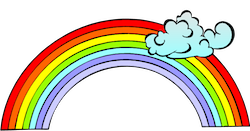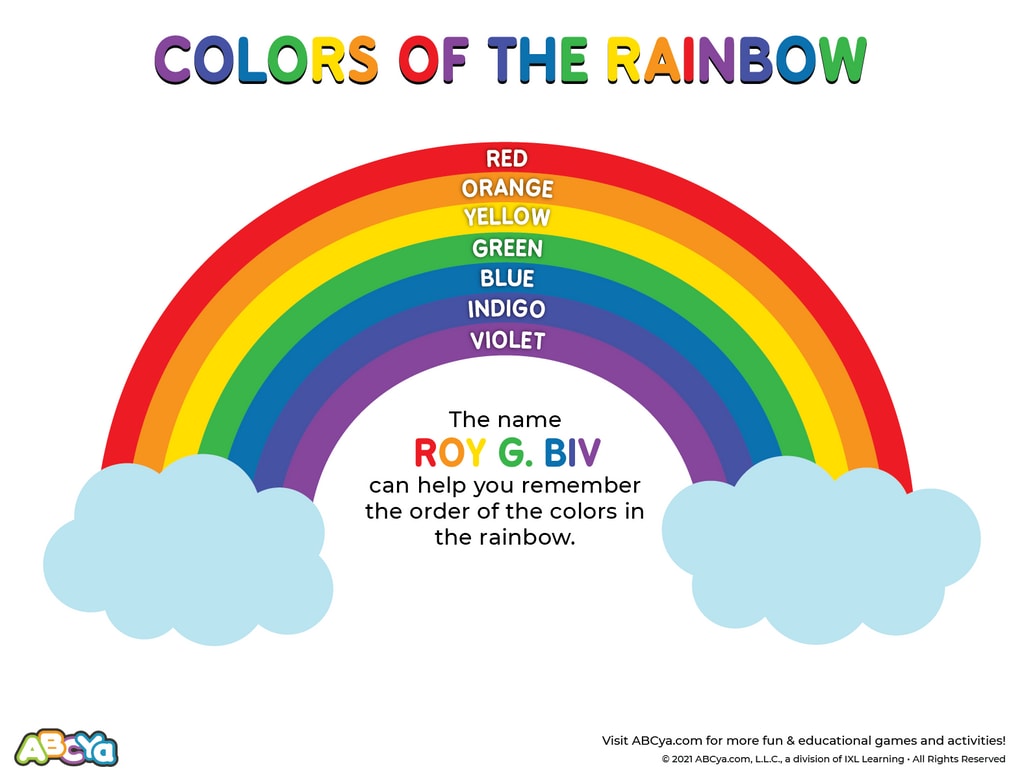We’ve all seen rainbows, those breathtaking arcs of color that grace the sky after a rainstorm. But have you ever stopped to wonder, “How many colors are there in a rainbow, really?” It seems like a simple question, with an equally simple answer. We all learned ROYGBIV in elementary school, right? Red, Orange, Yellow, Green, Blue, Indigo, Violet – seven colors, just like a rainbow. But is it as simple as that?

Image: www.englishclub.com
The answer, like most things in the world of science and art, is not as straightforward as it first appears. The rainbow’s spectrum is actually a continuous flow of colors, merging seamlessly from one to the next. We typically assign seven colors for easy categorization and understanding, but the reality is that there are infinitely many shades, hues, and tints within the rainbow’s spectrum. Let’s dive deeper into the science and history behind this fascinating phenomenon.
From Ancient Legends to Scientific Discovery
The rainbow has held a powerful place in human imagination since the dawn of time. Throughout history, it has been seen as a symbol of everything from divine power to good luck. In ancient Greek mythology, Iris, the messenger goddess, was said to travel across the sky on a rainbow. In many cultures, the rainbow served as a bridge between the mortal realm and the realm of the gods.
Even today, the rainbow continues to inspire wonder and awe. It’s a symbol of hope, diversity, and the beauty to be found in nature’s grand spectacle. But the beauty of the rainbow also hides a fascinating scientific truth. The rainbow is actually a phenomenon of light refraction, a process that happens when sunlight interacts with water droplets suspended in the air.
A Spectrum of Colors
When sunlight enters a water droplet, it’s bent and separated into its individual wavelengths, much like a prism separates white light into different colors. These wavelengths correspond to different colors, and they’re arranged in a specific order from longest to shortest – red, orange, yellow, green, blue, indigo, and violet. This is known as the visible spectrum, because it’s the only part of the electromagnetic spectrum that we can see with our eyes.
However, the visible spectrum is not simply a list of seven distinct colors. It’s a continuous gradient, with an infinite number of shades of color blending seamlessly from one to the next. The sharp lines we perceive between red, orange, yellow, and the rest are merely our brains’ way of categorizing and simplifying the information received by our eyes.
Why We See Seven Colors
So why do we see seven colors in a rainbow? It’s not just because our eyes are limited, though that’s partly true. The number seven is a cultural construct based on the traditional breakdown of the visible spectrum. Isaac Newton, the renowned mathematician and scientist, was the first to identify seven distinct colors in the rainbow spectrum in the 17th century. He chose seven because he believed that seven was a magical number, representing the seven tones of the musical scale and the seven known planets in the solar system at that time.
However, Newton’s choice of seven colors has been debated over the centuries. Some argue that indigo is barely distinguishable from blue and violet, and it’s more of a shade of blue than a distinct color. Others propose that there should be more than seven colors, suggesting that orange and indigo are simply transitions between other colors.

Image: www.abcya.com
How Many Colors Are There, Really?
The truth is that there’s no definitive answer to the question of how many colors are in a rainbow. It depends on how you define “color” and how we perceive it. The visible spectrum is a continuous range of wavelengths, and each wavelength corresponds to a specific shade of color. So theoretically, there are an infinite number of colors in a rainbow.
But in practice, our eyes and brains can only perceive a limited number of colors. We typically categorize the spectrum into seven distinct colors, but there are countless shades in between. The beauty of the rainbow lies in its continuous, ever-changing flow of colors, the way they merge and interact to create an infinite range of natural hues.
Beyond the Rainbow
While the rainbow may appear as a simple arc of colors, it represents a complex phenomenon of physics, optics, and perception. The rainbow serves as a reminder that there’s more to the world than meets the eye, and that the boundaries of our perception are constantly being expanded by scientific discovery.
As we continue to explore the mysteries of light and color, we gain a deeper appreciation for the breathtaking beauty of our universe and the intricate ways in which we perceive it. The rainbow serves as a timeless symbol of both wonder and scientific inquiry, a testament to the beauty and complexity of the natural world.
Actionable Insights for an Enriched Life
Understanding the science behind the rainbow empowers us to appreciate the beauty of the natural world even more deeply. We can also use this knowledge to explore the world of color through art, photography, and even design. Whether you’re exploring the nuances of color theory in your art practice or simply admiring the sunset’s colors, a deeper understanding of the rainbow can enrich your experience.
Beyond the Basics: The Rainbow’s Hidden Secrets
The rainbow’s beauty and mystery have intrigued humans for millennia. Here are a few fascinating facts about this spectacle of nature:
- Rainbow’s Shape: Rainbow’s aren’t actually arcs; they’re full circles. We see only a portion because the ground obscures the bottom half.
- Double Rainbow: A double rainbow is created by sunlight reflecting twice within the water droplets, resulting in two rainbows. The inner rainbow has the colors in the typical order, while the outer rainbow has the colors reversed.
- Rainbow’s Location: You can’t chase a rainbow; it’s always positioned at a specific angle relative to the sun and the observer. The observer must stand in a specific position to see the rainbow.
How Many Colors Do The Rainbow Have
https://youtube.com/watch?v=Xb5cpBCcPRY
Expanding Our Horizons
The rainbow is more than just a pretty sight in the sky. It is a window into the world of light, color, and perception, a reminder of the boundless wonders of our universe. So, the next time you see a rainbow, take a moment to appreciate its beauty and to reflect on the scientific knowledge and cultural history behind it. It’s a reminder that the world is full of mysteries and wonders, waiting to be explored.






